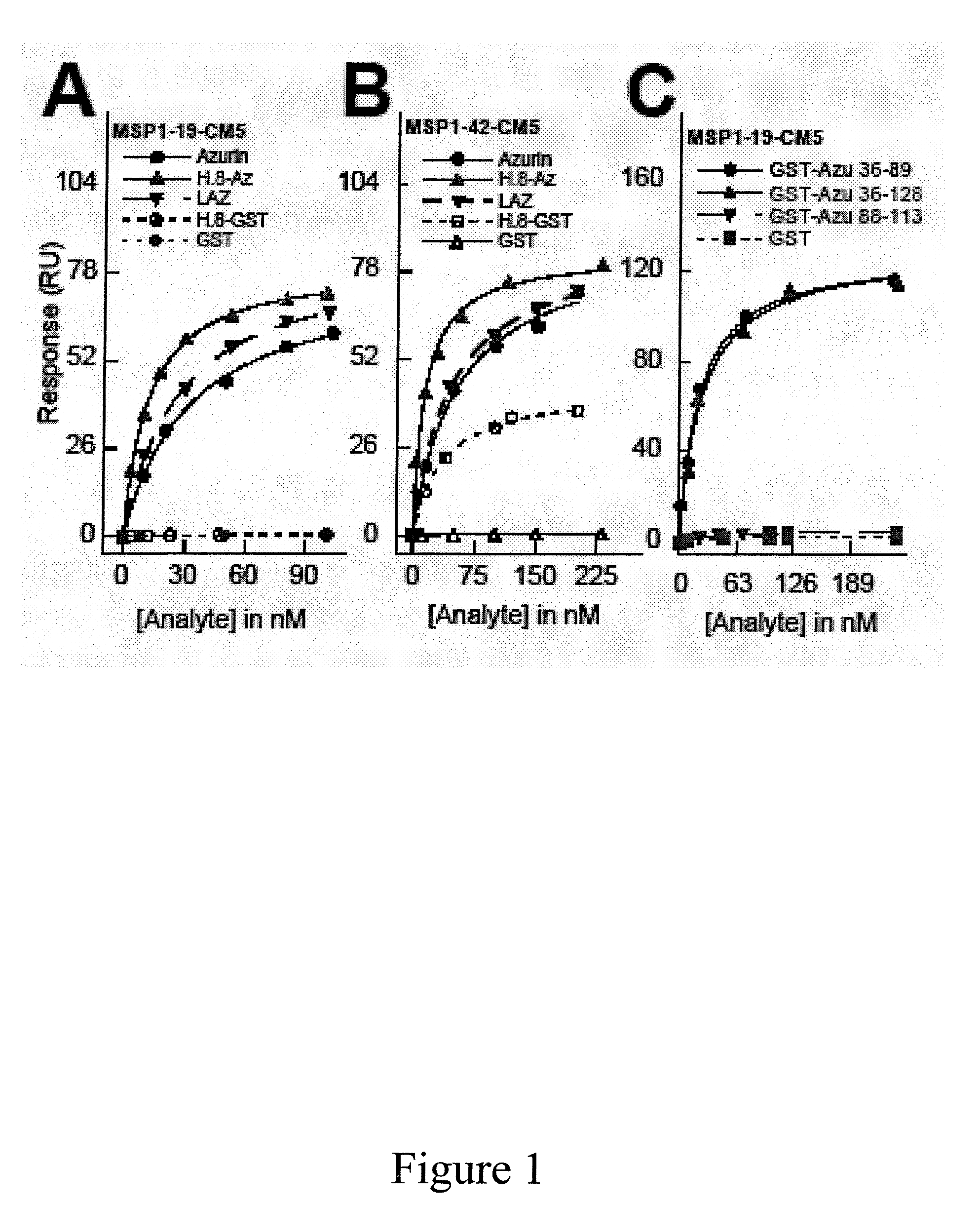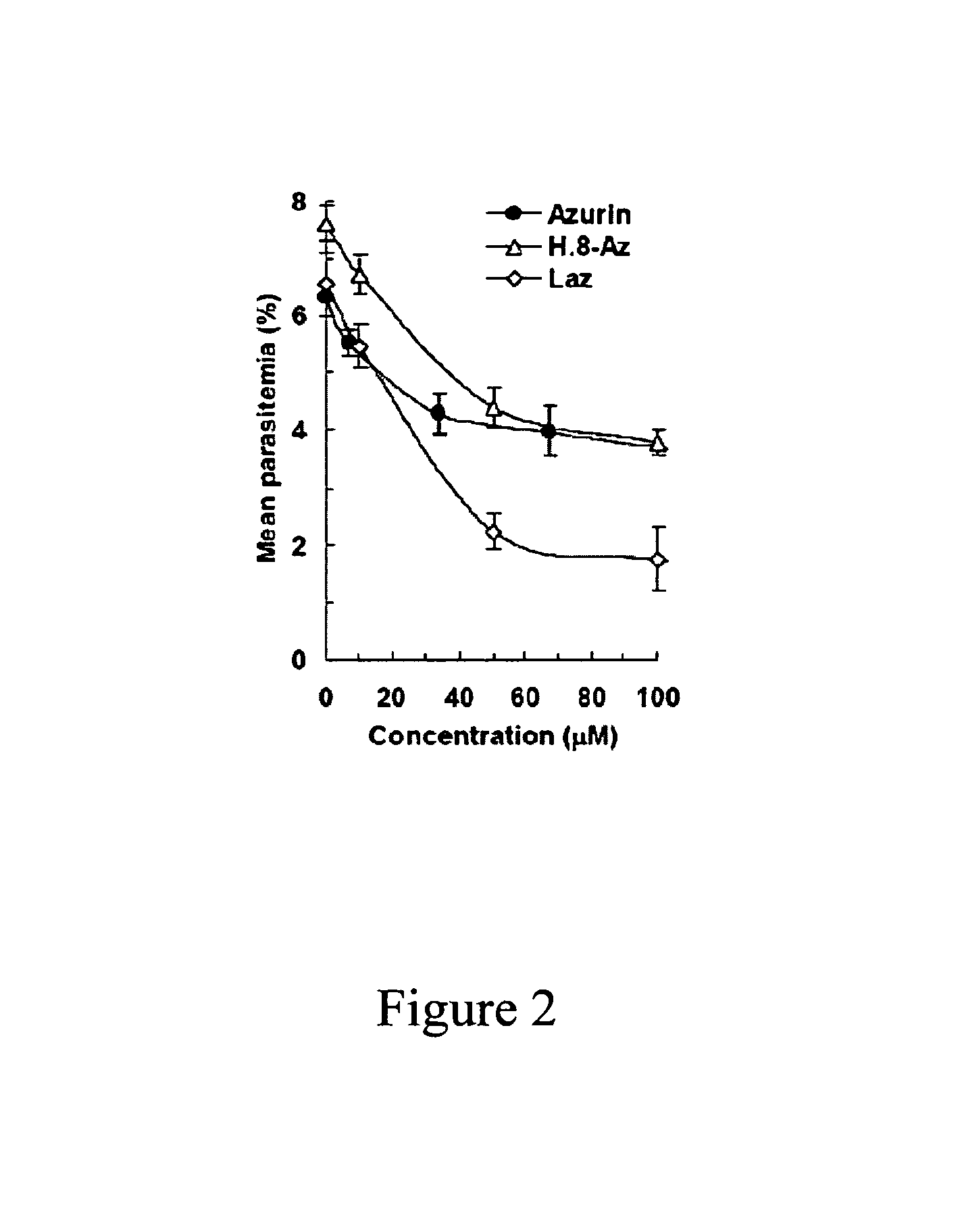Compositions and methods for treating malaria with cupredoxin and cytochrome
a technology which is applied in the field of cupredoxin and cytochrome to achieve the effect of inhibiting the spread of parasitemia
- Summary
- Abstract
- Description
- Claims
- Application Information
AI Technical Summary
Benefits of technology
Problems solved by technology
Method used
Image
Examples
example 1
In Vitro Inhibition of P. falciparum Parasitemia by Cupredoxin and Cytochrome
[0185]The cupredoxins bacterial wt azurin, M44KM64E azurin, rusticyanin and cyanobacterial plastocyanin, as well as the cytochromes Pseudomonas aeruginosa cytochrome c551, human cytochrome c and Phormidium laminosum cytochrome f were tested in a normal red blood cell (RBC) assay at 200 μg / ml concentrations at 30 hours post inoculation. In these experiments, the normal RBCs were washed twice in serum free media and resuspended to 10% hematocrit in complete RPMI. 200 μl of 10% Hct RBCs were added to each of 24 wells (final 2% Hct at 1 ml) in addition to 30 μl complete RPMI containing recombinant cupredoxin or cytochrome proteins at 666 μM for a final concentration of 200 μM. Schizont-stage parasites were prepared by centrifuging a late-stage culture through a Percoll cushion at 3200 rpm for 10 minutes. For infection, 4×106 parasites / well in 500 μl volume were added at t=0 hr. The plate was incubated for 30 ho...
example 2
Inhibition In Vitro of P. falciparum Intracellular Replication by Rusticyanin
[0188]To determine if the bacterial redox proteins can inhibit intracellular replication of the malarial parasites, red blood cells were loaded to an intracellular recombinant protein concentration of 200 μg / ml using a hypotonic ghost preparation. Cells where then washed, resuspended and infected with schizont-stage parasites (P. falciparum) as described in Example 1. The red blood cell ghosts were incubated for 19 hours and 40 hours and giemsa smears were made.
[0189]Compared to the infections of normal red blood cells in Example 1, only rusticyanin decreased total parasitemia in loaded cell ghost cultures. At 19 hours, there was no significant difference in invasion and ring formation, with empty ghosts at 5.0±0.4% and rusticyanin-loaded ghosts at 4.5±1.0%. However, at 40 hours, rusticyanin-loaded ghosts had a lower level of infection. No major effects were seen at 19 hour with any of the bacterial protein...
example 3
Structural Homology Between Azurin and Fab Fragment of G17.12 Monoclonal Antibody Complexed with Pf MSP1-19
[0191]Previous studies have shown that cupredoxins show structural similarity to the variable domains of the immunoglobulin superfamily members. (Gough & Chothia, Structure 12:917-925 (2004); Stevens et al., J. Mol. Recognit. 18:150-157 (2005)) The DALI algorithm (Holm & Park, Bioinformatics 16:566-567 (2000)) was used to search the 3D databases for structural homologs of azurin (1JZG) from P. aeruginosa. Azurin exhibits structural similarity to the Fab fragment of G17.12 monoclonal antibody in complexation with Pf MSP1-19 fragment of the MSP1 merozoite surface protein of P. falciparum. (Pizarro et al., J. Mol. Biol. 328:1091-1103 (2003).) (Table 6) Azurin also exhibits a structural similarity to ICAM-1 (Table 6), which is involved in cerebral malaria and implicated as a receptor on the endothelial cells in the microvasculture of the brain and other tissues for sequestering P. ...
PUM
| Property | Measurement | Unit |
|---|---|---|
| Fraction | aaaaa | aaaaa |
| Fraction | aaaaa | aaaaa |
| Fraction | aaaaa | aaaaa |
Abstract
Description
Claims
Application Information
 Login to View More
Login to View More - R&D
- Intellectual Property
- Life Sciences
- Materials
- Tech Scout
- Unparalleled Data Quality
- Higher Quality Content
- 60% Fewer Hallucinations
Browse by: Latest US Patents, China's latest patents, Technical Efficacy Thesaurus, Application Domain, Technology Topic, Popular Technical Reports.
© 2025 PatSnap. All rights reserved.Legal|Privacy policy|Modern Slavery Act Transparency Statement|Sitemap|About US| Contact US: help@patsnap.com



